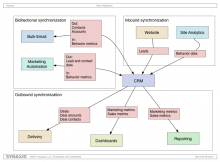In the modern world two things are true: 1) systems need to share data and 2) you can't easily rebuild or replace legacy systems. Often it's easier and more effective to integrate systems than to collapse them into one system. While data integration has often been cumbersome or unreliable, our solution can make the process less so, while producing the same benefits of custom integrations.
Challenge
With more and more specialized application required for business and communication, there is a tendency for your sales and marketing data to reside in many different systems. At time goes on, each system builds up its own data. This means two things. 1) Similar data in different systems become a version control problem. What was once “in sync” is now different. And it’s hard to know which is the proper or more accurate data. 2) Each system has only part of the story. Once system might have static customer data, while another has dynamic behavioral data for each customer. If you can’t combine that data, you are missing important insights.
Solution and Benefits
 Data wants to fragment, and you need a plan to prevent this chaotic tendency. A proper data integration strategy can make sure that you know the correct version of the data. And it can identify important connects between data sets. To accomplish this, you need a data map that shows objects and fields and how they relate. To operationalize a plan like this, you need systems and tools that can connect different systems. This can be done through in-app connectors, data integration tools (e.g. Talend), or with custom programming using system APIs. Once this is accomplished, your data can flow in appropriate directions and also be connected to reveal important connections.
Data wants to fragment, and you need a plan to prevent this chaotic tendency. A proper data integration strategy can make sure that you know the correct version of the data. And it can identify important connects between data sets. To accomplish this, you need a data map that shows objects and fields and how they relate. To operationalize a plan like this, you need systems and tools that can connect different systems. This can be done through in-app connectors, data integration tools (e.g. Talend), or with custom programming using system APIs. Once this is accomplished, your data can flow in appropriate directions and also be connected to reveal important connections.
Approach
Implementing a data integration solution involves these steps:
- First, we work with you to understand your organization and gather your requirements.
- Then, we create the tool to suit these needs.
- Once this is complete, we can help you rollout the system to your organization.
Gathering Requirements and Solution Design
First, we work with you to understand your data and requirements. This takes several steps:
- Review current marketing and sales data systems—We find and catalog all current systems. This means identifying all objects and fields in each system as well as any connections.
- Create the data map—develop a detailed map that shows the desired future state of data flow
- Discuss plan with the teams and leadership—Before we implement anything, we need everyone. We want to make sure we are making a plan that will work for your organization.
This phase assumes that everything “works”, so it serves as much as a roadmap for training as for for the rest of the work. Once this phase of the work is complete, you will have a good understanding of what needs to get implemented and why.
Installing and Configuring
With the documented future state in hand, we can implement the technology to operationalize the data map. Depending on the requirements, this can mean several different kinds of work:
- Install or implement the data hub—for sales and marketing data, we recommend using your CRM to be the data hub for all information.
- Developing synchronization solutions—based on the inbound, outbound, or bidirectional synchronization required, we create Finding ways to gather metrics from various systems—sometimes a good dashboard requires data from many sources. Or, it requires different metrics to be combined before display. In these cases, we introduce a data warehouse (like in Macroscope).
- Develop real-time integrating tools—in some cases, we don’t need the data to “move”, we just need access to it when we need it. These types of solutions are especially important for reporting or dashboarding tools.
Rolling Out
Once this is complete, we can help you rollout the system to your organization. This means much more than just “flipping the switch”. Rather, we make sure that the right teams have the right documentation. Beyond that, we can provide live, online, or hands-on training for teams or individuals.
